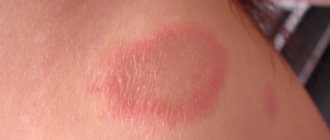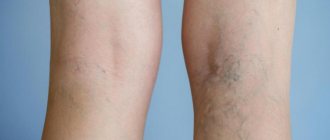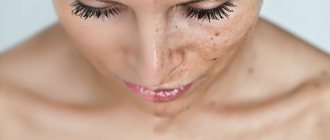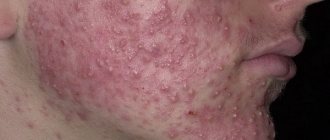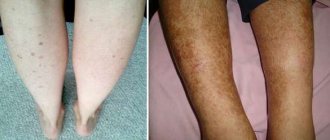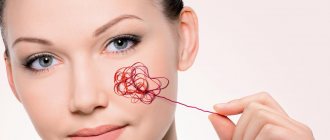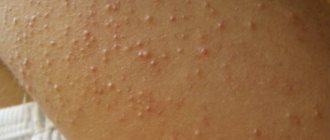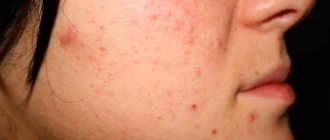Symptoms
The most common signs of allergies include the following:
- skin irritation, redness, itching, swelling, blisters, peeling, crusting, rash, itching, scarring of the skin on the face;
- wheezing, chest tightness, cough, or shortness of breath;
- swelling or bumps on the face and neck, eyelids, lips, tongue or throat, hoarseness, headaches;
- stuffy nose, runny nose;
- redness of the eyes, itching, swollen eyelids;
- pain, nausea, vomiting, diarrhea;
- feeling tired, sore throat, dizzy.
Features of correction
If you have learned from your own experience what an allergy on the face looks like, you should not self-medicate, as the condition may worsen. In addition, many people are hypersensitive to pharmaceutical products. If the condition is severe, the doctor will probably prescribe intravenous medications. This is required if angioedema has developed, as well as other severe manifestations.
To minimize a relapse, it is recommended to undergo hyposensitization treatment, as well as learn a number of rules regarding the everyday life of an allergy sufferer. Hyposensitization refers to complex measures whose task is to reduce the body’s susceptibility. The patient receives a small amount of a dangerous compound for a long time. Since the dose is carefully adjusted, it is enough to form immunity, without the danger of a pronounced response from the body. If conditions, time, and the patient’s condition allow such therapy, gradually the manifestations of sensitization will weaken, over time, susceptibility completely disappears, and the person can live a normal life. Such treatment usually requires several years.
Causes of allergies in adults
Below we list the main causes of this disease.
Seasonal allergies
Seasonal allergies occur in early spring and cause facial reactions such as redness, blistering, itching, and swollen eyelids. If you are allergic to cold, the same symptoms appear, but in this case it is necessary to avoid drafts and cold rooms.
Severe allergies can lead to allergic conjunctivitis, which is an inflammation of the lining of the conjunctiva.
Animals and insects
Some animals may cause allergic reactions.
People allergic to cats/dogs do not react to animal hair or fur - the first symptoms of an allergy are caused by the saliva and individual particles of the four-legged skin. People suffering from this allergy experience symptoms such as sneezing and drowsiness. Allergic reactions caused by animals also include hives and rashes not only on the face but throughout the body. Bites from insects such as bees or mosquitoes can cause similar symptoms.
Contact dermatitis
A rash on the face can appear upon contact with a plant or any other object containing an allergen. This type of allergic reaction is called contact dermatitis. The allergen can range from poison ivy to a food you touched or a new brand of laundry detergent.
Note. When using cheap cosmetics, a rash may appear on the face.
Symptoms do not only appear in the area of the body that you touched. The most dangerous manifestation of contact dermatitis is contact of an allergen on the skin of the face or in the nose.
Food
Food allergies are one of the most common types of sensitivities affecting the skin of the face. The severity of food allergies ranges from stomach pain after eating certain foods to rashes and swollen lips.
Severe, life-threatening food allergies can cause the tongue and airways to become swollen. This type of reaction is called anaphylaxis and requires immediate medical attention.
Medicines
Drug allergies vary in severity and the types of symptoms they cause. The most common symptoms of intolerance to certain medications (or rather, some components) are skin rashes on the face and hands.
A drug allergy can also cause hives, facial swelling, and anaphylaxis.
Eczema
With a disease such as eczema, rashes and peeling appear on the following areas of the body:
- face;
- neck;
- hands;
- knees.
The cause of eczema, or atopic dermatitis, is not well understood.
People with asthma or seasonal allergies are most susceptible to this condition. Eczema can also be associated with food allergies.
Types and symptoms of the disease
Allergic reactions are divided into two types:
- fulminant. Signs appear within a short period after contact with the allergen;
- delayed. Symptoms on the skin become noticeable after a few hours or days.
With various forms of dermatitis, either one or several signs appear. The rash may be accompanied by spots, swelling, and erosions.
Main symptoms:
- primary rash;
- secondary rash;
- swelling;
- eczema;
- allergic contact dermatitis;
- red spots.
The variety of manifestations after the action of the stimulus often makes it difficult to make a diagnosis. Don't try to solve the problem yourself! Be sure to visit a dermatologist.
Read more about unpleasant manifestations. Remember the main symptoms.
Primary rash Appears:
- ulcers (pustules). Cavities filled with pus. Deep pustules after resorption leave scars on the skin;
- nodules (papules). Small red swellings. Dimensions – from 3 to 30 mm. The formations are painless and disappear after healing, leaving no trace;
- vesicles. The tubercles of exfoliated epidermis are filled with exudate - a reddish or clear liquid. Often appear with severe skin lesions, for example, atopic dermatitis;
- blisters. Acute inflammation of the upper layer of the dermis. The formation itches and there is a burning sensation. The appearance of blisters is accompanied by slight swelling.
Secondary rash Characteristic:
- scales. Appear after the disappearance of papules, vesicles, pustules. The reason is the detachment of dry pieces of the epidermis of a gray, yellow color that peel off;
- scabs. Signs of prolonged dermatitis. Crusts are formed from the dried liquid of dead pieces of the epidermis;
- erosion. Appear on the skin after opening of pustules and vesicles. The size and shape are the same as those of ulcers. The erosive surface is easily infected.
Small red dots appear on the body. What is this? We have the answer!
How to get rid of a thorn on your foot at home? Read an interesting article at this address.
Eczema One of the most unpleasant manifestations on the skin. Inflammation can be acute or chronic. Redness, dryness, peeling are observed in the affected areas, and primary and secondary rashes develop. Often problem areas are covered with painful cracks. (Find out more about eczema at this address).
Erythema Red spots do not rise above the skin; they cannot be distinguished by touch from healthy areas. The cause is increased blood flow, temporary expansion of capillaries in the affected area. (There is a separate article about erythema of the nose).
Hyperemia (redness) The sign is noted in areas of varying sizes. Hyperemia accompanies many diseases - lupus erythematosus, exudative erythema, and other types of allergies.
Quincke's edema The severe form is of the fulminant type. The reaction manifests itself on the lips, eyelids, cheeks, larynx, oral mucosa, and around the eyes. There are no painful sensations. Swelling of the larynx without assistance leads to death (suffocation). (Read about Quincke's edema here).
Allergic contact dermatitis A reaction that occurs at the site of exposure to the allergen. The area of skin turns red, swells, vesicles and papules appear.
Untimely prescribed treatment aggravates the process with exudative diathesis, causing a lot of suffering to the patient. In advanced cases, signs of contact allergies spread to neighboring areas.
Anaphylaxis
Anaphylaxis is the most severe manifestation of an allergic reaction. Anaphylaxis, or anaphylactic shock, is an extreme reaction of the immune system to an allergen.
Symptoms of anaphylaxis include:
- lack of air in the throat and chest;
- swelling of the face, lips and throat;
- hives or red spots on all parts of the body;
- difficulty breathing, whistling when exhaling;
- extreme pallor or redness of the face.
Attention! At the first symptoms of anaphylactic shock, seek emergency medical help immediately. Ignoring anaphylaxis can be fatal.
Allergy treatment
Important! Before treating facial allergies, you should consult your doctor. Self-therapy leads to irreversible consequences and complications.
Allergy treatment is provided depending on the speed of the reaction. Therapeutic methods for treating different types of allergies differ from each other. Fulminant and delayed types of allergies are treated differently.
Lightning type
Quincke's edema is a severe allergic reaction, the symptoms of which appear instantly and do not require delay or self-medication. You should immediately call a rescue team, and before the ambulance arrives, it is advisable to take an antihistamine to help relieve swelling.
In case of acute allergies, help will be provided by Suprastin, Tavegil, Diphenhydramine, Erius, Claritin, Cetrin, Fexadin and other medicines, at least one of them should preferably be stored in a home medicine cabinet.
Attention! Allergic Lyell's syndrome is characterized by an immediate course. Blisters quickly form on the skin of the face and other parts of the body, which burst, and the epidermis becomes covered with erosions. An allergic reaction is accompanied by high body temperature, and if you do not call an ambulance as soon as possible, death is possible.
Facial allergy Quincke's edema
Slow type
With a slow type of allergy, the processes occur sequentially and slowly. Typically, red spots appear on the face, which subsequently begin to itch and cause discomfort. The itching and redness are accompanied by a rash on the cheeks, chin and nasolabial triangle.
The sequence of actions for a patient suffering from a delayed type facial allergy:
- Determine the cause contributing to the irritation and allergic reaction. It is advisable to remember what you ate, drank, what medications you took recently, petted someone’s cat, came into contact with synthetic fabrics, etc.;
- Limit contact with the allergen - if you neglect this rule, the allergy will move from the acute stage to the chronic stage;
- Before visiting a doctor, wipe your face with a cotton pad soaked in a decoction of chamomile, calendula, string, and sage. The herbal decoction has an antiseptic and sedative effect;
- Make a compress using boric acid. Dilute 1 tsp. a glass of water and periodically apply moistened gauze to your face;
- Take an antihistamine - the sooner the substance begins to fight allergies, the faster the symptoms will go away;
- Visit an allergist or dermatologist, who will diagnose allergies using proven methods and then choose treatment tactics.
Note! Treatment depends on the severity of the allergic process.
Eczema on the face After collecting anamnesis and tests, the doctor prescribes treatment for allergies on the face. Therapy is most often complex and may consist only of oral or local medications. The process of curing allergies consists of the following methods:
- restoration of the immune system;
- removing allergens from the body and purifying the blood;
- antihistamines.
Diet
After diagnosing a food allergy, it is necessary to adhere to a certain diet that excludes foods and dishes containing the allergen from the list.
For example, if you are allergic to peanuts, all dishes containing this product are excluded from your diet. If you are allergic to milk, you need to find other sources of protein and calcium.
In addition to the ban on eating certain foods, it is highly recommended not to smell them, touch them, or eat other foods with traces of the allergen. Cutlery, dishes, kitchen surfaces and cutting boards should be completely free of unwanted products.
When purchasing salads and drinks, carefully study the ingredients. Even some soaps, pet foods, paints and glues may contain traces of food allergens.
Allergic symptoms taking into account the location of the lesion
In most cases, allergy symptoms appear for specific reasons. So, redness can be observed on the chin, cheeks, and forehead. But there are some peculiarities.
A rash usually does not appear in the eyes, but swelling, redness, lacrimation appears, and the mucous membrane becomes inflamed. The lips are also mucous membranes, like the eyes, so rashes are rare, and with an individual reaction on the inside of the lips, patients complain of blisters. Also, the lips become swollen, and the tingling sensation does not stop until the allergy subsides.
Allergies in the ears are manifested by severe redness and itching, which leads to flaking. Most often, an allergic reaction to the ears is a consequence of contact dermatitis or food allergies.
What to do if you have an allergy on the face, severe swelling
Allergy on the face of a child
Children are more susceptible to developing rashes than adults. There are different causes of rashes in children, and the location of the rashes can give clues to the underlying cause. Symptoms such as the appearance, physical description of the rash, fever and respiratory infections make it much easier to find the cause in order to eliminate it.
Infections
Infections are one of the most common causes of rashes on the face and around the eyes in children. Skin infections caused by several types of bacteria contribute not only to the appearance of rashes, but also to the further development of allergies. The most common bacterial infection on the face in children is impetigo. This infection appears as a honey-colored, patchy rash around the lips, nose, or eyes.
In this case, the use of antibiotics is necessary to avoid complications in the form of a chronic course of the disease and allergic reactions. Another type of infection that spreads around a child's eyes is called periorbital cellulitis. This is a potentially dangerous condition that can cause an eye abscess.
Children's allergies
Allergies that are not caused by complications of third-party diseases are much less common in children. It manifests itself in the form of allergic reactions to pollen and other seasonal allergens. It is also possible to be hypersensitive to foods in your daily diet. Atopic dermatitis and allergic rashes occur in only ten percent of children under ten years of age.
Babies with lactose intolerance are susceptible to a more aggressive form of the rash, which appears at birth and only improves after using formula instead of milk. Older children are allergic to dairy, shellfish and peanuts.
Symptoms in children with seasonal allergies appear in the spring. The rash causes itching and discomfort. In some cases, it is recommended to remove foods containing allergens from the child’s diet.
Note. the child’s diet must be agreed upon with a nutritionist.
Systemic diseases
There are a number of diseases that affect the entire body, in which the appearance of a rash on the face is only one of many signs and symptoms. Typically, one of these diseases is lupus. Patients with this systemic, autoimmune disease are prone to developing a red rash on the face (most of which occurs around the eyes and nose).
Iron and protein deficiency can lead to a weakened immune system, which in turn can lead to allergies to certain foods. Zinc deficiency also causes facial rashes in children. In order to eliminate these signs, it is necessary to fill the deficit of missing elements.
How to find out what causes acne and allergies
Allergies in the form of acne on the face are especially annoying for those who have a high sensitivity to certain foods. Most often, the disease occurs soon after an allergen has entered the body - one of the substances to which a person has an excessive reaction. The most common food allergens include:
- Chocolate and cocoa delicacies.
- Oranges and other citrus fruits.
- Red berries.
- Exotic fruits.
- Seafood.
- Whole milk.
- Honey.
- Fish.
- Canned food and foods with food additives.
The disease can be confirmed using blood tests and special skin tests. During scarification screening, very small scratches are made on the inside of the forearm and one or another allergen is dripped onto them.
If you have acne from allergies, redness will appear at the site of contact with the irritant. Such diagnostics allows not only to identify a substance harmful to health, but also to select the correct treatment.
Allergies in newborns
While most newborn rashes are not serious, some require close medical monitoring:
- Thin blisters filled with yellowish fluid indicate a serious bacterial infection (such as herpes).
- Small red or purple spots on the face ("petechiae") are caused by a viral or bacterial infection. Any manifestation of such symptoms requires immediate medical attention.
Causes of the disease
Every girl wants to be irresistible. Natural, natural beauty, of course, is valued, but young ladies and mature young ladies still prefer to use cosmetics. What to do if it suddenly turns out that the fair sex is allergic to cosmetics?
Allergists have studied this problem quite closely. And this is what turned out.
As it turns out, many people are allergic to cosmetics, but medical luminaries believe that girls with skin that is overly sensitive to irritants most often suffer. The most annoying thing is that allergies appear exactly where everything should be perfect - on the face. It is important to diagnose allergies to cosmetics in a timely manner.
Rash on face during pregnancy
One in five pregnant women experience skin problems during pregnancy, including conditions such as acne, darkening of the skin and stretch marks. These manifestations are normal for a pregnant woman. Urticaria during pregnancy is much less common and most often goes away without complications.
Hives are an allergic reaction to food, insect bites, medications and chemicals. With the changes in hormone levels that occur in a pregnant woman's body, the body becomes more sensitive to pathogens, which causes rashes on the face and throughout the body. In most cases, this disease goes away on its own, without the use of additional medications.
What causes hives during pregnancy?
With the onset of pregnancy, the body undergoes many serious changes that lead to skin problems. Pregnant women often experience aggressive bouts of itching, hives or rashes, and 1 in 150 pregnant women develop a more serious skin condition that causes blisters and plaques to appear on the face.
Hives are caused by allergic reactions. Dryness and stretching of the skin, together with other changes, makes the female body more susceptible to the appearance of rashes during pregnancy. Moreover, such a reaction over a certain period of time can be caused by almost anything that enters the body.
Common causes of hives during pregnancy:
- medicines;
- insect bites;
- chemicals;
- pollen;
- animal skin cells;
- products (milk, nuts, shellfish).
Hives can also be caused by mechanical injuries, stress, or bedsores.
Advice. To avoid aggravating the situation, do not ignore the appearance of hives; consult a specialist to prescribe medication.
Another condition that triggers the appearance of hives on the face is cholestasis of pregnancy. This pathological process also causes severe itching, nausea, vomiting and pale skin color. This condition directly indicates the presence of liver problems. Its danger lies in the spread of the rash to internal organs, which can be fatal.
Acne on the lower back
Acne on the lower back causes enormous discomfort, because in any position a person experiences discomfort due to constant itching and burning.
Allergic acne does not affect everyone, since a person's immune system can react differently to a particular allergen.
Photo 37 - Acne problem on the lower back
The mechanisms for the appearance of allergic acne on the lower back are always interconnected with the way the allergen enters the body:
- through the respiratory tract (animal fur, etc.);
- through the skin (applying low-quality cosmetics, etc.);
- through the gastrointestinal tract (food, etc.).
In addition, the appearance of acne on the back can be caused by excessive sweating, poor hygiene, as well as abuse of strong drinks or working in hazardous conditions and other reasons.
Photo 38 - Pimples on the lower back cause discomfort Pimples on the knees
If acne occurs on the knee, it is necessary to limit the entry of various allergens and irritants into the human body or contact with them. The affected area should be treated, the rash should be washed under water with laundry soap or chamomile decoction. Tea tree oil or olive oil have an excellent and most importantly quick effect. If your knees start peeling, you can apply aloe vera gel. The gel should be applied directly to the pimple, and in the evening, apply olive or tea oil.
Photo 41 – The problem of acne on the knees
Various rashes on the face occur for various reasons. By carefully studying the features of neoplasms, you can first determine the cause of their occurrence. This will simplify the choice of drugs for their treatment. Allergic acne that appears on the skin of the face is easy to distinguish from other types of rashes based on certain signs.
Allergies in the form of acne are strikingly different from ordinary pimples or acne, which occur when the glands are blocked, but this type of allergy has similar symptoms to such pathological manifestations as demodicosis or dermatitis. To accurately recognize the disease, it is necessary to carefully study their characteristics and the factors contributing to their appearance.
Treatment
Allergy symptoms such as redness, itching and swelling of the face often go away on their own within a week of onset.
A few tips will help you get rid of these signs much earlier.
- Avoid contact. During an exacerbation of allergies, do not touch the causative agents of your illness. To be on the safe side, avoid strong odors from soaps, powders, and detergents.
- Hydration. A cold compress or shower will help relieve the itchy rash for a while. Do not wash your face with large amounts of water; simply moisturize the skin on your face.
- Oatmeal mask . Colloidal oatmeal is a powdered oatmeal that mixes easily with water. An oatmeal mask will help soothe inflamed skin. Unfortunately, some skin types do not tolerate such products well. To avoid additional damage, use warm water, as boiling water will worsen the situation.
- Antibacterial cream . Hydrocortisone cream or calamine ointment are ideal for eliminating symptoms.
- Wet compress. Any cotton towel will do for a compress. Soak it in water and squeeze it out, then leave this compress on your face for a while. It is not recommended to get rid of the compress earlier than after 30 minutes.
Not all allergic reactions can be eliminated at home; in severe cases, consultation with a specialist is necessary.
Remember. Allergic reactions may indicate more serious illnesses.
Allergy tablets for the face
As strange as it may sound, there are no medications to treat allergies. All drugs available in pharmacies remove symptoms, but do not stop the process itself. These drugs are called antihistamines, and they eliminate swelling and reduce the amount of rash. Combination drugs such as corticosteroids are used much less frequently.
In some cases, the use of immunomodulators (for example, Isoprinosine) is allowed to reduce the body's sensitivity to the allergen.
Antihistamines
Antihistamines are used to relieve allergy symptoms. They are available as tablets, solution, nasal spray or eye drops.
Over-the-counter antihistamine eye drops relieve itching and redness around the eyes, while nasal sprays are used to treat seasonal or year-round allergy symptoms.
- Over-the-counter drugs. Cetirizine (Zyrtec), Fexofenadine (Allegra), Levocetirizine (Xyzal), and Loratadine (Claritin, Alavert) come in tablet form. Brompheniramine (Dimethapp), Chlorpheniramine (Chlor-Trimeton), Clemastine (Tavist), and Diphenhydramine (Benadryl) may cause side effects such as drowsiness and weakness. Ketotifen (Zaditor), Naphazoline and Pheniramine are eye drops.
- Prescription drugs. Desloratadine ( Clarinex) comes in tablet form and has no serious side effects. Astelin is a nasal spray that helps get rid of rashes around the nose and eyes. Prescription-only antihistamine eye drops include Optivar, Elestat, and Patanol.
Treatment Options
Before you begin self-rescue, make sure that you have not made a mistake in your diagnosis. Often this pathology manifests itself with signs reminiscent of other dermatological ailments. And improper treatment will only worsen the situation.
We must understand that the manifestations of allergic reactions on the skin of the face are only side effects of diseases. And if the rash is cured, this does not mean that the disease is cured. Spots on the face, itching and rashes may indicate that the liver is contaminated and simply cannot cope with its barrier functions. Therefore, external therapy must be used in conjunction with cleansing the organ.
So, we suggest checking the effect of these alternative therapy options:
- Mumiyo. “Mountain Tears” is the popular name for a remedy that is considered one of the best allergy fighters. 1 gram of mumiyo should be diluted in half a glass of boiled water. Wipe the face with the solution 4-5 times a day. It is useful to drink this liquid 2-3 times a day before meals, 50 grams to cleanse the body. By combining the internal and external use of mumiyo, you can quickly get rid of allergies on the face.
- Mix of juices. It is prepared from carrots, cucumber and beets in a ratio of 3:1:1. To achieve an antiallergic effect, you need to consume 2 glasses of the mix per day. This is a recipe for internal cleansing of the body and strengthening the immune system.
- Chalk. It is used when the eyelids suffer greatly from allergies. You need to grate it, wet your fingers and carefully apply it to your eyelids. This procedure is recommended to be carried out 3-4 times a day.
Noticed a mistake? Please highlight the text with the error and press Ctrl+Enter to report it to the editors.
Nowadays, a person has a lot of opportunities to stop and slow down age.
At this age it is already difficult to maintain an attractive appearance with creams and masks.
Nowadays, women of any age resort to hair removal of various parts.
Prevention
Spring and early summer are the most dangerous time for allergy sufferers. It is during this period that the exacerbation begins. Poplar fluff and pollen are common in spring and can irritate the skin on the face and cause other symptoms.
In a chronic course, it will not be possible to avoid exacerbation, but you can prepare for it in such a way that the symptoms do not develop beyond the initial stage. Below are several recommendations that will help prevent seasonal exacerbation without the use of medications.
Note. Despite the fact that the symptoms subside for some time, do not forget about regular examination by an allergist-immunologist.
Drink more fluids
For hives on the face and nasal congestion, increase your water intake. Having plenty of H2O in the body will reduce the amount of mucus and help prevent the rash from spreading further throughout the body.
Considering that the body perceives certain elements as pathogens, water will significantly reduce toxicity in your body, completely neutralizing the allergen. This is an ideal remedy during seasonal allergies. If, in addition to these symptoms, swelling of the face is observed, then use the method below.
Skin hydration
Seasonal irritants affect more than just the nose, eyes and lungs. Without proper skin hygiene, allergens can cause damage to your face.
Dry skin is covered with many microcracks, which makes it more susceptible to environmental irritants. To keep your skin moist, use a regular compress with a damp towel for dry skin, and avoid makeup for a while. If this is not possible, wash off all makeup from your face before going to bed.
Allergens - pests
Fragrances are the cause of allergies to cosmetics
Any beauty wants to not only look presentable, but also smell like a fragrant spring flower. But what are perfumes made of? The substances used in modern times are of synthetic origin, whereas previously perfumers resorted exclusively to ingredients of animal origin. Nowadays, only sophisticated scent connoisseurs can afford this.
Substances of animal origin
In expensive perfumes we can find musk, amber and civet - substances of plant origin. Ambergris is obtained from the stomach of male whales. This substance is used to fix and preserve odor on the body for a long time. Musk is an ingredient with a rather pungent odor, which can often be found in masculine scents. In nature, animals mark their territory this way. Civet comes to the rescue when a perfumer creates a unique oriental scent. It is these components that cause allergies to cosmetics.
Substances of plant origin
What is a fragrance without the use of subtle notes of floral compositions? Rose attracts with its delicate aroma, jasmine with its audacity, oriental flavor is achieved through the use of sandalwood root. The smell of iris remains in the memory for a long time, just like lavender. With all the charm of these odors, it is important to remember that all of the above are powerful allergens and you should not once again put yourself at risk by not passing an allergen test.
Processing: continuing the procedure
After finishing applying the compress, you need to dry the skin. If you have an allergy, it is undesirable to aggressively influence the skin with chemical or mechanical factors. Use a clean towel for drying. You cannot rub your face; you can only gently blot the liquid. Particularly allergic areas are sprinkled with rice starch or potato starch. An alternative is a cream with chamomile extract.
After drying the skin, it is necessary to treat it with a special ointment. These are sold in most modern pharmacies. There are steroid compounds that are effective against a number of symptoms, but are relatively dangerous and can cause side effects. In addition, they can also cause allergies. There are non-hormonal ointments. These contain anti-inflammatory components and are indicated if the process is accompanied by a severe reaction. In case of complex flow, combined formulations are indicated. You should not prescribe such medications on your own; you should first consult a doctor. Nonsteroidal and steroidal medications are sold by prescription only. To ease irritation before visiting a doctor, you can apply an ointment containing panthenol. This product is safe, softens and moisturizes the skin, stimulates regenerative processes. The drug is distributed over the face in a thin layer.
White rash on chin
A white rash that appears on the chin may indicate one of the following problems:
- stomach disease caused by Helicobacter Pylori;
- intestinal pathologies;
- the presence of a skin parasite (fungus or molluscum contagiosum);
- inflammatory process in the body.
However, small white rashes on the lower part of the face may be one of the accompaniments of puberty, the “rebellion of hormones” characteristic of this period. Therefore, it is important not to seek treatment on your own, but to turn to specialists to accurately identify the cause.
Dermatitis on the chin in women
Dermatitis often occurs on the chin in women because this area is very sensitive to external influences, and internal organs also project their problems onto the skin of this area. Rashes can have a different character, depending on their culprit.
Atopic
Atopic dermatitis, characterized by dry skin, itching, and redness, can occur during a stressful period, a cold, or pregnancy. But these are all provoking factors. And the main reason is a tendency to allergies. Intolerance can be of various types, most often the culprit is poor nutrition. We are not talking about sweets or fatty foods, but foods that a woman should not eat at all. These may be fruits or nuts that are healthy for most other people.
Atopic dermatitis
Success in the treatment of atopic dermatitis largely depends on diet.
Contact
Contact dermatitis manifests itself:
- dryness;
- cracks;
- redness;
- swelling;
- rash in the form of blisters;
- in severe cases, erosive changes on the surface of the epidermis, pain;
- previous signs may be supplemented by a general deterioration in health and elevated temperature.
The malaise fully lives up to its name, arising as a response to contact with a substance intolerable to the body. The culprits of rashes are cosmetics, other household chemicals, fabric, jewelry that the skin of the chin comes into contact with. One of the elements of treatment should be the avoidance of a substance that is rejected by the body.
Allergic
Allergic dermatitis can occur regardless of whether the skin has touched a substance intolerant to the body. Sometimes it is enough to stay in the open sun or cold for a short time, inhale the aroma of a flower along with pollen, so that rashes appear on the lower part of the face.
Allergic dermatitis
Allergic dermatitis can also be provoked by foods, cosmetics, and medications. When substances that are not accepted by the body get inside, the immune system begins to fight them, resulting in redness, a small rash, and swelling on the chin. They should be combated, including by eliminating the allergen from the patient’s everyday life. But it must first be identified.
Diagnostics
If a rash occurs on the chin and does not go away for a long time, you need to undergo a diagnostic examination. It must be comprehensive, so you will need to visit an allergist, dermatologist and therapist. An examination is necessary to identify and study the causes of the development of a negative reaction, and to develop a treatment regimen. The process takes into account the intensity of symptoms and the general condition of the patient.
In order to understand why your chin itches intensely, you will need to donate blood (general analysis). Since allergies on the chin can have a different nature, allergy tests are included in the diagnostic examination to confirm or exclude possible irritants. Any red or pink spot on the chin indicates certain problems, so specialized tests will help identify the underlying irritant. In the diagnostic process, the area of the lesion is taken into account - if the rash on the chin is intense, the degree of damage is large, minor areas indicate that the disease is in a mild form.
The following measures allow you to identify a rash on the chin and establish the main causes of the pathological process:
- determination of immunoglobulin content in the blood (analysis);
- performing allergy tests (special markers with an irritant in the amount of 20-30 pieces are injected under the skin).
The test is necessary so that allergies on the chin can be eliminated quickly, with the use of effective medications. The tests will give the specialist an understanding of what irritants cause a negative reaction in the body from the immune system. You can also study the red spot that appears on the chin by scraping the skin, which is carried out in the affected area. This method makes it possible to eliminate problems in the field of dermatology.
Important! Testing must be carried out in a medical office setting. An allergist constantly monitors the patient's condition. In case of a strong reaction or a sharp deterioration of the condition, he uses medications that act on the irritants.
If the skin on the chin is actively peeling and red, the causes of the condition will be identified after a diagnostic examination. The main irritant can be recognized by the condition of the skin. A positive reaction to an allergen manifests itself in the form of redness nearby, increased rash, and blisters. Also, when a rash appears on the chin, perioral dermatitis may be diagnosed. In this case, the diagnosis does not end. The patient undergoes an additional examination - differential diagnosis, since the symptoms have much in common with problems such as:
- seborrheic dermatitis;
- diffuse neurodermatitis;
- rosacea;
- allergic contact dermatitis;
- steroid acne.
Rash and peeling, irritation on the chin
Rash and peeling that forms on the chin can be caused by:
- Perioral dermatitis. These are small pimples around which the skin turns red, and between them you can see small scales. Sometimes this area of the face itches or even hurts. The appearance of the problem is often provoked by the wrong choice of cosmetics, or the simultaneous use of several products with incompatible components. It can also be caused by the use of corticosteroid drugs. Contacting the skin, they irritate it.
- Hormonal imbalance. If rashes are found on the chin, you need to check the functioning of the thyroid gland, as well as the ovaries. An excess of some hormones and a deficiency of others leads to disruption of sebum production, clogged pores, and peeling.
- Poor nutrition and negative changes in the gastrointestinal tract. Spicy and fatty foods, an abundance of sweets lead to the digestive system being overloaded, and this is reflected in the condition of the epidermis of the lower part of the face.
Skin irritation can be detected on the chin in women for less significant reasons than those listed above:
- allergy to the fabric of a scarf or turtleneck sweater, which often comes into contact with the epidermis;
- sudden change in weather;
- colds, chapping;
- stress;
- vitamin deficiency and, as a consequence, suppressed immunity;
- hypervitaminosis.
A woman may not attach importance to these factors, but they can affect the condition of her chin.
